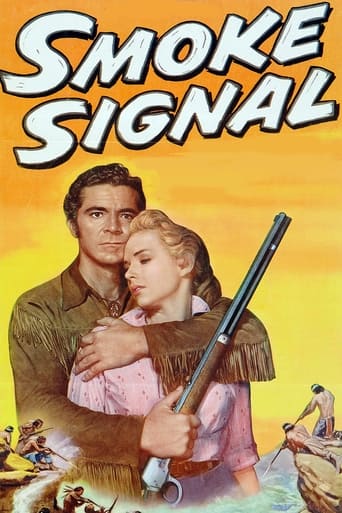bkoganbing
Smoke Signal stars Dana Andrews as an army deserter who left because his late commanding officer was hell bent on starting an Indian war which he did. When the Indians went on the offense Andrews deserted them and is now a prisoner.Now the commander is dead and Andrews is a prisoner at his fort. But that might not mean much as most of the fort is dead and the Utes are closing in. There one chance for the survivors and it means heading down the Colorado River which as yet is unexplored, especially around that Grand Canyon area. One woman the late commander's daughter Piper Laurie, one trapper Douglas Spencer and a bunch of soldiers led by Captain William Talman who has a special reason for hating Andrews as his brother was killed in a battle with the Utes. But it's pretty clear that Andrews is the one guy who really knows what he's doing.The film is mostly the journey down the Colorado River where we see who makes it and who doesn't. Only six are left in the boat at the end, you have to see which six.Nice location cinematography and good ensemble performance by a veteran cast.
dbdumonteil
Since "broken arrow" it had become politically correct to treat the Indians as human beings and it was about time!Like James Stewart ,the hero lived with a tribe,married a squaw (who died too) ,but it was a bad idea cause he was a military man and by leaving his "people " behind ,he became a deserter .He was captured and held prisoner in a fort in jeopardy for the Indians are all around.The only way is the river which runs through the canyon.The screenplay is predictable to a fault ,the female part (Piper Laurie)is essentially decorative ,but the landscapes are worth the price of admission.Like Richard Widmark in " the last wagon" ,Dana Andrews will "redeem himself" (but he is actually so noble there is nothing to redeem indeed).This is a "river movie" ,in which the enemy is actually not the Indians but the dangerous waters and the white men's jealousy and hatred .Like this ? try these..."River of no return" ,Otto Preminger "The far horizons" ,Rudolph Maté
Marlburian
As a child in the 1960s I watched as many Westerns at the cinema as possible, and "Smoke Signal" was one of those that left a lasting impression. I had to wait many years for it to be shown on British TV, and then it wasn't quite as good as I'd remembered, but still quite novel, with the US Cavalry taking to the boats to escape Indians. Certainly the Grand Canyon made a spectacular background to much of the film, though with the white protagonists being confined to two small boats quite a lot of rather obvious back projection was necessary whenever one of them spoke.Few films of the 1950s (or indeed of any period)dared omit a female from the cast, however contrived her inclusion might be, and here we have Piper Laurie visiting her father at one of the most primitive forts I've seen portrayed in a film at a time of tension with the Indians.
silverscreen888
This fine production is in every way one of the best westerns, and the best adventures ever made by my standards. It is also a "sense-of-life" film, during whose course the viewer along with the characters discovers the truth about the central character for himself. The plot situation here is a tense one. This script has in fact one of the most interesting story lines of any western of which I have knowledge. A man named Halliday is being called a renegade, even accused of having started an Indian war. Yet Brett Halliday is a man who deserted to join the Ute Indians--who have now joined the Sioux---on a previous occasion for what he says was a different reason entirely. His story was he wanted keep the peace then and still does, but Evans, the man in charge at the local fort, wanted the war. The man who has captured him, Harper, leads his patrol back to the fort. Laura Evans, the Colonel's daughter, is also present. Her father is dead; and an overwhelming attack on the fort is now imminent. With no other choice, the few survivors have to make their way down the walls of the canyon beside which the fort is perched and try to escape via the river that flows there. The body of the film's many action scenes involve that attempted escape and Halliday's part played during it, which finally convinces a by-the-book Harper to let him go to the Indians and try to avert needless bloodshed. By this time, he has told the daughter the truth about her father--that he brought on the two wars by the way he had maltreated the tribes. And she has fallen in love with him and will wait for his return. Veteran Jerry Hopper directed the colorful scenes contained herein from a script by George W. George and George Slavin. In the good cast beside Dana Andrews, very good as Halliday, young star Piper Laurie as Miss Evans, William Talman in a his best role ever in film as Harper, Milburn Stone just before he achieved fame as "Doc" on "Gunsmoke's" long-running TV series, Rex Reason as Laura Evans' jealous suitor, Gordon Jones, Robert J.Wilkie, Peter Coe, Douglas Spencer and William Schallert. There are many good technical and creative contributions that make this a beautiful and memorable outdoor drama. Bill Thomas did the costumes and other fine professionals were involved; but the plot line concerning how men face adversity is so strong that a lesser cast, producers and artists could still have made this a creditable effort. That they did so much better than they might have done is a tribute to all concerned.


